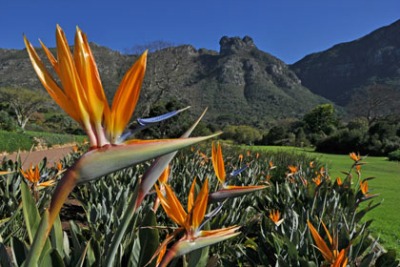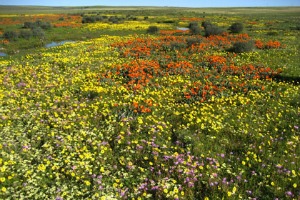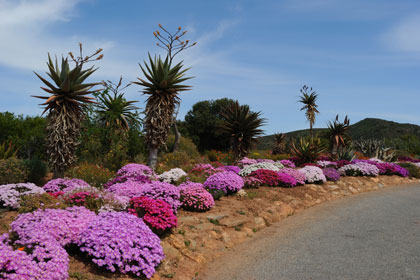Calling all garden lovers! You may have been lucky enough to visit the RHS Chelsea Flower Show or like me, you are currently enjoying the TV coverage from the comfort of your armchair. Always stunningly beautiful and inspiring, the Chelsea Flower Show has me itching to get out in my garden and copy some of their ideas. However somewhere else in the world really inspired me when I visited it a few years ago. South Africa.
 South Africa is one of the most wonderful places to visit if you are interested in gardens and rare or unusual plants. South Africa has a fabulous climate which means it is home to some stunningly beautiful gardens. I am going to focus on the nations wonderful botanical gardens which are run by SANBI, the South African National Biodiversity Institute. They manage 10 National Botanical Gardens with an emphasis on preserving the indigenous plants and natural habitats which are so unique to South Africa and they are fantastic places to visit as a tourist.
South Africa is one of the most wonderful places to visit if you are interested in gardens and rare or unusual plants. South Africa has a fabulous climate which means it is home to some stunningly beautiful gardens. I am going to focus on the nations wonderful botanical gardens which are run by SANBI, the South African National Biodiversity Institute. They manage 10 National Botanical Gardens with an emphasis on preserving the indigenous plants and natural habitats which are so unique to South Africa and they are fantastic places to visit as a tourist.
South Africa’s National Botanical Gardens
The ten national botanical gardens are Kirstenbosch, Pretoria, Walter Sisulu, Free State, Hantam, Harold Porter, Karoo Desert, Kwelera, Lowveld, and KwaZulu-Natal. Altogether they make up over 7,400 ha of natural habitats and vegetation now protected for future years. They also provide a wonderful tourist attraction for local economies with nearly 1.5 million visitors a year. Kirstenbosch, is one of the world’s very best botanical gardens and it has almost a million visitors a year on it own. It’s also one of my favourite places to visit when I am in Cape Town.
Kirstenbosch
 Kirstenbosch is one of the most dramatically scenic botanical gardens in the world, as it sits nestled on the inland side of Table Mountain in Cape Town. Kirstenbosch is also one of the world’s most important botanical institutions as it is home to some of the rarest species of plants. The garden was established over a hundred years ago by English botanists who settled in Cape Town. It makes the most of its stunning backdrop and the wonderful balmy climate to focus on the vast and diverse indigenous flora of South Africa. This creates a very natural atmosphere perfectly at home within the landscape and large sections of its huge acreage have been left as native fynbos. Many visitors head straight for the Protea garden and these South African flowers, showy and strange, have become popular now in the UK and can be seen at Chelsea! The botanists based at Kirstenbosch are still making important scientific discoveries on a regular basis.
Kirstenbosch is one of the most dramatically scenic botanical gardens in the world, as it sits nestled on the inland side of Table Mountain in Cape Town. Kirstenbosch is also one of the world’s most important botanical institutions as it is home to some of the rarest species of plants. The garden was established over a hundred years ago by English botanists who settled in Cape Town. It makes the most of its stunning backdrop and the wonderful balmy climate to focus on the vast and diverse indigenous flora of South Africa. This creates a very natural atmosphere perfectly at home within the landscape and large sections of its huge acreage have been left as native fynbos. Many visitors head straight for the Protea garden and these South African flowers, showy and strange, have become popular now in the UK and can be seen at Chelsea! The botanists based at Kirstenbosch are still making important scientific discoveries on a regular basis.
Hantam
 Situated just outside Nieuwoudtville, award winning Hantam is one of the world’s very special biodiversity treasures and the first National Botanical Garden in the Northern Cape. This, unlike Kirstenbosch, is a relatively new botanical garden having been founded in 1982, but it has been a popular public garden since the 1800’s. The natural vegetation of this area, Gauteng, is known as the ‘Rocky Highveld Grassland’ and it accommodates over 600 naturally occurring plant species. This kind of vegetation means that it is home to plenty of wildlife including a breeding pair of Verreaux’s Eagles nest on the cliffs alongside the waterfall. There are over 220 birds species recorded on site and a number of reptiles and small mammals, including small antelope and jackals.
Situated just outside Nieuwoudtville, award winning Hantam is one of the world’s very special biodiversity treasures and the first National Botanical Garden in the Northern Cape. This, unlike Kirstenbosch, is a relatively new botanical garden having been founded in 1982, but it has been a popular public garden since the 1800’s. The natural vegetation of this area, Gauteng, is known as the ‘Rocky Highveld Grassland’ and it accommodates over 600 naturally occurring plant species. This kind of vegetation means that it is home to plenty of wildlife including a breeding pair of Verreaux’s Eagles nest on the cliffs alongside the waterfall. There are over 220 birds species recorded on site and a number of reptiles and small mammals, including small antelope and jackals.
The Karoo
The Karoo Desert National Botanical Garden is different to all the others as it specialises in a wide variety of desert and semi-desert plants. The 154 hectare Garden lies at the foot of the Hex River Mountain range in the arid Karoo Desert region north of Cape Town. Only a small part is cultivated and the rest is all wild and natural giving the visitor a great chance to explore a natural but protected environment. There are also two fantastic hiking trails here. This is the place to come if you are interested in desert plants such as cacti and succulents and the best time to come is in the South African spring (August and September) when many of them are flowering and the sight is spectacular.
Kwazulu-Natal
The beautiful and tranquil KwaZulu-Natal National Botanical Garden is in the east of South Africa and once again has its own special atmosphere created by the local landscape and natural vegetation. It too was set up by Victorians and they added a fascinating collection of rare specimens of northern hemisphere plants, such as the swamp cypress, tulip trees, camphor trees, plane trees, giant figs and magnolias. There is even an avenue of London plane trees which is over 100 years old! Of course there are plenty of local plants from the eastern grasslands such as Clivia, Gerbera, Kniphofia and Watsonia. It is also a protected environment for local birds with over 150 species recorded. Another fabulous section of the garden is the fascinating Useful Plants Garden, which displays local plants used by the Zulu people for medicine, craft, and food.
The scenery here is much as you would expect in this stunningly beautiful region. There are two main rivers which cut through the gardens and they create spectacular waterfalls and there are two wonderful viewpoints to see them. The Crocodile and Nels Rivers create the green and lush scenery and the African rainforest section which has some unique plantlife as well as a suspension bridge with great views over the tumbling river below. Various plant species have been introduced into the Garden in order to conserve them including South African coastal species and a unique collection of plants which represent the rapidly disappearing tropical forests of central and west Africa.
If you fancy a tour of the best of South Africa’s gardens then give us a call. We tailor-make all our holidays and we can create a holiday around specific gardens and any other interests you have.
Posted by Ruth Bolton

